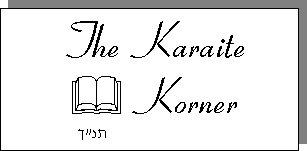

The Torah commands us to tell over the story of Exodus on the first night of Passover. The Karaite Haggadah uses the Biblical narrative to retell this story.
The Torah commands us to tell our children about the Exodus from Egypt and ordains that the first night of Passover is to be a "night of watching" (Ex 12,42). In earlier times the Israelites fulfilled these requirements by staying up all night eating the Passover sacrifice and re-telling the glorious story of our redemption from the oppressive hand of the Egyptians. Since the destruction of the Temple all that can be fulfilled is the telling of the story. "Haggadah", which means "telling", does just that, it tells the story of the Exodus. Unlike the Rabbis, the Karaites do not claim that their Haggadah is the required text which must be read in order to fulfil the requirement of commemorating our redemption from Egypt; such a text does not exist or it would have been commanded in the Torah. Instead the Karaite Haggadah is one possible "telling" of the Biblical story (or to be precise two possible tellings, see below). Unlike the Rabbanite Haggadah, the Karaite Haggadah does not tell stories about Mishnaic Rabbis or delve into Midrashic corruptions of the Biblical narrative but instead uses Biblical quotations to tell the story of the Exodus, interspersed with short explanations and blessings.
The Karaite Haggadah exists in two versions, the "Egyptian" and the "Russian" versions, each of which developed in the two great centers of late Karaism (Cairo and Crimea, respectively). Both versions are written entirely in Hebrew and this division represents two of the major historic centers of Karaism. The two versions have similarities but also diverge drastically at some points. In general, the Russian version seems fuller while the Egyptian seems abridged. For example, the Egyptian will often quote a single verse dealing with the Exodus while the Russian will quote the entire Biblical passage. The "Blessing after the Meal", which takes up about a third of the Haggadah in the Egyptian version and about a fourth in the Russian version, is identical in the two versions except that the Russian version omits the section from "These are the feasts" until "as he hath commanded us". Despite all the differences there can be no doubt that the two versions derive from a single earlier version which evolved differently in these two great centers of Karaism. The Egyptian version presented below is based on the Hebrew text published in Jerusalem in 1973 while the Russian version is based on the Hebrew text published in Odessa in 1901. The full citations are as follows:
"Order of the Haggadah of the Feast of Passover According to the Custom of the Karaite Jews", The National Religious Council Publication, Jerusalem 1973
"Haggadah or Small Hallel for Passover Eve According to the Custom of the Karaites with a translation in the Russian Language, Each Item in its Place", Shlomoh Firik, Odessa 1901
Most of the Karaite Haggadah consists of Biblical verses. The translation of the Biblical portions presented here are in general based on the King James Version with slight modifications. The divine name (YHVH), which the King James inaccurately translated as "LORD" (in capital letters), has been replaced with the Hebrew "YHWH", representing the original Hebrew Yod-He-Vav-He, the divine name of God. Non-Biblical portions were translated by Nehemia Gordon and are marked at the end of each passage as "(NB)", that is "Non-Biblical". The non-Biblical sections have been bolded so as to distinguish them.
In a number of instances the verse numbers in the English Bible are off by one or more from the verse numbers in the Hebrew. This usually takes place when the English Bible fails to count short sentences. When such a difference takes place the English Bible verse numbers are marked in square brackets.
At several points the original text included instructions which were not to be read as part of the service. The original text put these in small print but we have placed them in square brackets.